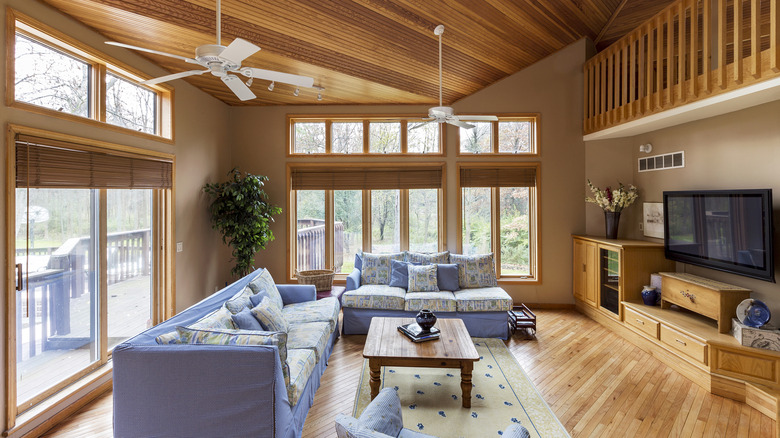The Ceiling Fan Hack To Keep Your Home Cool In The Summer
Installing one of the top-rated energy-efficient ceiling fans for your home is a smart way to reduce your energy bills. When used in conjunction with your air conditioner, the ceiling fan makes the air inside your home feel cooler. It's similar to the wind outdoors — it feel cooler than the actual temperature when it's breezy out. Using your ceiling fan allows you to turn up the thermostat a few degrees without sacrificing comfort. You'll then lower your air conditioning bill.
Beyond just running the ceiling fan, you can improve its ability to make you feel cooler by doing a simple check on the unit's operation. When operating the ceiling fan in summer, you'll feel cooler when the blades are spinning counterclockwise. The blades on this device have a slight angle when attached to the ceiling fan housing, which creates a downdraft in the air. This feels like a light breeze moving through the room, which cools your skin. Heat escaping your body warms the air around you, but a breeze moves that warm air away and replaces it with cooler air, helping you feel cooler. A typical angle for the blades is 12 degrees. You can adjust it to create a steeper angle, but anything more than 16 degrees could create too much air speed and blow items around the room.
To reverse the direction of most ceiling fans, just flip a toggle switch on the section where the blades are attached near the pull string. If the blades are incorrectly spinning clockwise in summer, turn off the fan and move the switch in the opposite direction. When you restart it, the blades should start spinning counterclockwise. Some new models let you change the blade direction using a remote control or smartphone app.
Other considerations when running a ceiling fan to stay cooler in summer
To determine which direction the ceiling fan is turning, stand under it and look up while it's spinning. For the summer, you want it to be turning counterclockwise as you look up at it from below. You should also feel the airflow blowing down on you. If your fan blades are spinning backward (clockwise) in the summer, it creates an updraft that forces warmer air near the ceiling to flow lower in the room, which might warm up the space. You won't feel downward air movement during clockwise blade spinning. This is a better setting for winter ceiling fan operation as it can keep the air circulating without making the room feel colder.
Before changing the direction of the blades' operation, you should use hacks to keep the ceiling fan dust-free. Dust and pet hair accumulates on the leading edge side of the blade that matches the direction of spin. When you turn off the ceiling fan to flip the toggle switch and reverse the direction of the blades, this is a good time to remove dust.
Remember, this ceiling fan hack only makes you feel cooler when you're in the room. It doesn't actually cool the temperature in the house like the air conditioner can. If you're focused on reducing your electric bill as much as possible, you shouldn't leave your ceiling fan on if you aren't home because it will just use electricity without providing direct benefits to keep you feeling cooler. A single ceiling fan costs $2 to $5 per month to operate on your electric bill. If you have multiple ceiling fans, the savings add up if you only run them when you're home. There's also no reason to install a ceiling fan in unoccupied rooms because it doesn't contribute to cooling the room's temperature.

